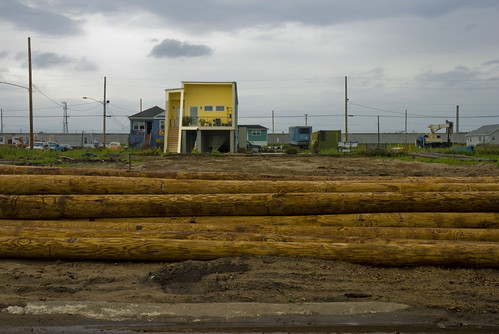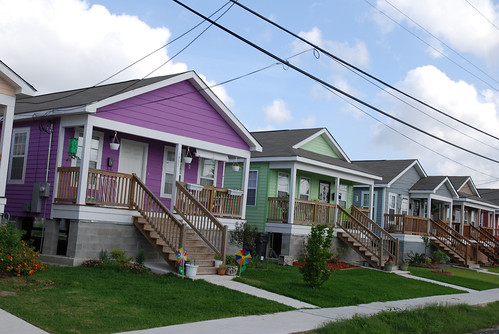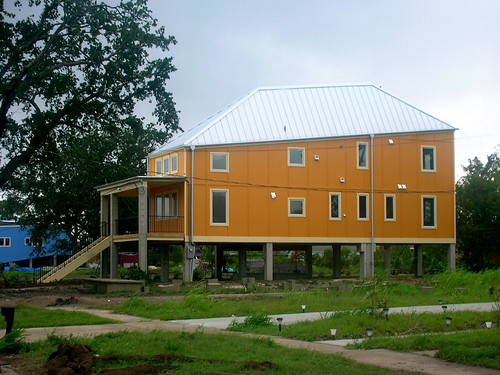No Place Like Home: Design and Architecture in post-Katrina New Orleans
I am very eager to respond to Eric Heiman’s observations and experience so far at Project M and The Rural Studio which he discussed in his June 20th post “Dispatch from Alabama #1: Cynics Need Not Apply.” The issues of housing, the ownership of space, and the role that artists play within sustainable and community based projects are all very dear to my heart.
There is an endless amount of housing issues in the Bay Area from foreclosures, to redevelopment, to tenants rights violations—issues I have become more familiar with recently through my work with the San Francisco Housing Rights Committee. However after reading Eric’s post my thoughts immediately turned to the rebuilding efforts in New Orleans after Hurricane Katrina, specifically Brad Pitt’s project called the Make It Right Foundation (MIR). This comes as no surprise as I spent the past two years researching and writing about housing politics and the concept of home in New Orleans through my graduate thesis project entitled, “Homesick: The Search for Belonging in New Orleans’ Landscape of Loss.” This project was inspired by my experience as a volunteer with the organization Common Ground Relief and focused on the presence of the non-local volunteers in post-Katrina New Orleans, the majority of whom are young, white activists from middle-class backgrounds and whose long-term presence in the city, while hopeful, contributes to New Orleans’ changing racial demographic.

A home built by Brad Pitt’s “Make It Right Foundation” at 1809 Deslonde Street in New Orlean’s Lower Ninth Ward. To the left of the house is the volunteer center for the organization “Common Ground Relief.”
While the issue of non-local people, particularly students, working within economically disadvantaged areas is relevant both to New Orleans and Greensboro, Alabama, what I’d like to consider here is the relationship of MIR to Eric’s discussion of beauty and utility within architecture and design. Pitt developed MIR after observing the damage of New Orleans’ Lower Ninth Ward neighborhood and meeting with local residents to hear their concerns and assess their housing needs. MIR aims to build hurricane-safe homes with “an emphasis on a high quality of design, while preserving the spirit of the community’s culture.” MIR has completed eight homes, however it is unclear to me if the residents who now live in these homes owned the property they were built on before the storm, nor is the affordability of the homes apparent. What MIR does make clear is that their homes are green and designed to withstand storms through elevation, roof access, hurricane proof windows, and durable materials.

A home built by Brad Pitt’s “Make It Right Foundation” at 1720 Tennessee Street in New Orleans’ Lower Ninth Ward.
When I returned to New Orleans last September, it was disheartening to realize that the houses in the Lower Ninth Ward where I worked in 2006 had been leveled—the once densely populated neighborhood was almost entirely vacant with high grasses covering the foundations where homes once stood. The only contrast to this seemingly open space were the houses built by MIR that line Tennessee Street and sit just in front of the Industrial Canal Levee. Now, I am not well-versed in the formal aspects of architecture or design but I do know that the MIR homes look more like model homes in a prefab modern suburb of Los Angeles than they do part of the unique landscape of New Orleans. Anyone who has traveled to the Big Easy knows that New Orleans is known for its dynamic architecture that includes Creole cottages, shot-gun houses, front porches, iron-cast lace balconies, and hanging baskets—architecture that is deeply rooted to the city’s French and Spanish colonial influences.
This is where the conversation of beauty and utility arises. Utility is covered—MIR homes are clearly environmentally sustainable and designed to function within hurricane country (however, it is not clear how they function in respect to economic status). Whether or not the homes are beautiful is subjective and not all that productive to consider. However, I am curious about the mission of MIR to “preserve the spirit of the community’s culture” through design and architecture. Our relationship to place and home has much to do with the familiarity of the material and visual landscape around us and indeed, for those long-time residents of the Lower Ninth Ward (a neighborhood with a high 48% of homeownership) the structure and contents of their house and the appearance of their residential block (not to mention their families and neighbors) provided a strong sense of belonging. I wonder if it is naive to think that design or architecture can recreate this, whether or not this is the role of MIR, and whether or not, in the context of repatriating New Orleans residents, this matters at all. One thing is certain, for a neighborhood with a history of neglect by the local government and a slow development of civil infrastructure, the MIR homes give the Lower Ninth Ward a steady push into the world of 21st century of design.
Of course there is also the issue of whether or not people should move back to the Lower Ninth Ward in the first place; an issue that I believe Pitt and those at MIR attempt to address. Hurricane Katrina proved just how vulnerable this part of the city is to flooding due in part to the failed levee system but also due to the Lower Ninth Ward’s geographical position downhill from the natural ridges built up by sediment along the Mississippi River. Yet, this is a nearly impossible conversation. Scott Bernhard, Chair of Architecture at Tulane University, summed this up in a meeting with me last September when he said, “How do you look someone in the eye and say, ‘We’re not going to rebuild your house, you can’t come home.'” The answer, I think, is that you don’t. And in this sense, then, perhaps Pitt and MIR do make it right irregardless of the disconnect between aesthetic choices and the visuality of New Orleans before the storm.
A project that is interesting to consider alongside MIR is “The Musicians Village” initiated by New Orleans natives, Harry Connick Jr. and Brandford Marsalis and sponsored by Habitat for Humanity. The Musicians Village restored an eight acre portion of New Orleans’ Upper Ninth Ward neighborhood including 72 single family homes, as well as duplex facilities for the elderly. The idea is that the designation of space for musicians will help preserve and cultivate the tradition of music that has shaped the city of New Orleans. Aesthetically speaking, these few city blocks in the Upper Ninth Ward keep intact the traditional New Orleans architecture of this neighborhood before the storm; one story ranch homes with front porches and occasional Creole cottages. The difference between the damage to the neighborhoods is important to consider. Since the Upper Ninth Ward was not as severely damaged by Katrina, The Musicians Village can be thought of as a rebuilding project, whereas the total obliteration of the Lower Ninth Ward allowed for a clean slate and building entirely from the ground up. Additionally, Habitat for Humanity volunteers rebuilt the homes in the Musician’s Village while Pitt, in all his humanitarian, rock-star status, hired designers, architects, and construction workers to make MIR homes a reality. Even considering the difference in scope and context of these two projects, I must say that there is something reassuring about the design of The Musicians Village coming from two New Orleans natives and being folded within the pre-existing architecture of the city.

Homes rebuild through Habitat for Humanity’s Musician Village project on Bartholomew Street in the Upper Ninth Ward in New Orleans
The question of the visual seems to be both complicated and incredibly pertinent within the rebuilding projects in New Orleans, as well as for Eric and his students at Project M. As Eric said in his post, “The visual still matters, but ceases to become the work’s main purpose for being.” As the fourth anniversary of Hurricane Katrina approaches this August and the effects of the storm have, for the most part, been removed from our collective consciousness, the main objective remains to bring displaced residents home. In this context, the issue of the visual does seem trivial and makes me wonder whether or not concerns for the visual are privileged. Regardless, the experience of shifting from concern for the conceptual and visual to what our work as artists can do and facilitate, as Eric mentioned, is an incredibly generative experience—one that has the possibility of dislodging us from our own self-prescribed roles, allowing us to constantly question and reaffirm why we do what we do and for whom.

Comments (7)
-
John-Paul Villforth says:
May 6, 2022 at 9:13 pm
-
Adrienne Skye Roberts says:
July 1, 2009 at 10:26 pm
-
Julian Myers says:
July 1, 2009 at 8:05 pm
-
Adrienne Skye Roberts says:
June 28, 2009 at 2:09 pm
-
Eric Heiman says:
June 24, 2009 at 10:58 pm
-
Tim Belonax says:
June 23, 2009 at 9:51 pm
-
Anuradha says:
June 23, 2009 at 8:49 pm
See all responses (7)It has been 13 years since the last comment but I wonder what became of all the folks that were temporarily housed in the Astrodome in Houston. If I remember correctly some didn’t ever want to go back to New Orleans and they either stayed in the Houston area or went to other places in America to rebuild their lives.
One question that concerns me is what happened to the land ownership in the Lower Ninth Ward. I understand the razing of damaged structures and structures that were no longer fit for human occupation. But what happened to homes that were covered by flood insurance and the ownership rights of individuals or families? Don’t they get to rebuild maybe to a higher standard?
It seems to me that areas of New Orleans prone to flooding should have been raised as new structures were built or the foundations should have been raised as a requirement to build. I have read great rebuilding stories of some folks where they rebuilt their shot gun home to a much higher standard than it was originally and one in particular that added a second story all the while preserving the original structural design. I really hope New Orleans makes a complete come back.
Thanks, Julian. I’ll go ahead and answer your questions. I am unaware of the response from local residents, however, judging from my experience working in this neighborhood, I imagine that the joy and relief in being able to return home outweighs any skepticism about the means through which this was made possible. And I am certain that the MIR houses do, in fact, suit the residents. This is where the irreconcilable feelings that I mentioned in my previous comment come in; if the goal is to return residents, which I believe it is, than MIR succeeds, however there are things I remain skeptical about. I do question whether projects like MIR should be built in familiar styles specific to local architecture and worry about, as Eric said in his previous post “the arrogance of the architect to think his or her modern vision supersedes any notions of history, context, or economics.” I am concerned about who controls the rebuilding, whose voice is heard, and whose projects gain publicity and therefore funding. Brad Pitt is a super-star and while his humanitarian efforts are well-received, there are many locally initiated rebuilding projects that will never get the same attention because they simply don’t make headlines the way Pitt does. Again, I think it is irreconcilable and perhaps this is one of the many reasons why I continue to think about this issue and other similar issues related to post-Katrina politics. I certainly don’t believe that economically disadvantaged communities are suspicious of modern design and hope that my post wouldn’t suggest that.
Hi Adrienne, I wanted to offer up a belated thanks for this post. I found really interesting and have been thinking about the questions it poses. I visited the 9th Ward on a student tour led by Matthew Coolidge in 2006, when very little had yet been built, and am fascinated to see how much, and how little, restoration has happened.
Early on you say “Whether or not the homes are beautiful is subjective and not all that productive to consider.” But aesthetics do seem to be at the center of your argument – you seem to be asking whether projects like MIR shouldn’t build in familiar, local vernacular, rather than contemporary, styles, inasmuch as “familiarity is key in regaining a sense of home.”
But I am less clear on what basis we ought to be skeptical of the MIR house. Have potential residents said anything for or against? Or are we embarrassed about them in some other way? The asymmetrically pitched roof does have an odd jaunty look, like the cocked brim of a hat, that takes some getting used to. And they look antiseptic. But I’m not sure why such a house wouldn’t suit residents just fine. It is not necessarily true that impovershed people are suspicious of radical or modern styles.
I think a lot of this discussion relates to memorialization and whether or not architecture can, within this context, acknowledge the tremendous effect of Katrina on the city and resident’s lives, while also moving forward beyond it. I agree that it is a false assumption to think one can restore neighborhoods like the Lower Ninth Ward to their pre-Katrina environment, however, as Tim mentioned, familiarity is key in regaining a sense of home. I also wonder more generally about Pitt’s role and have two divergent feelings – that the city needs all the help it can get through projects like MIR and yet, skepticism about celebrities influence in post-Katrina and general questions of who controls the rebuilding?
Adrienne, thanks for the great post and further elaboration on my thoughts. I can’t help but consider that, despite its good intentions, the Pitt/MIR project might suffer from a familiar pitfall—the arrogance of the architect to think his or her modern vision supercedes any notions of history, context, or economics. I’m not against Tim’s assertion that the architecture should reflect 21st century trends, I just wonder if the trends reflected are anything more than the architects’ singular aesthetic vision, the Ninth Ward site no more special or influential to their decisions than any other location. (See my soon-to-be-next post about the less successful Rural Studio projects.)
Concerns for the visual are not a matter of privilege, especially when discussing the visual aesthetics of a home. If a dwelling looks uninviting from the outside, it affects the residents as well as its visitor and the community as a whole. I believe your concerns for considering the aesthetics of New Orleans are valid but a key component the discussion is also context. The New Orleans that we knew was built a long time ago and reflected the heritage of its birth. It seems only fitting that the rebuilt and reclaimed areas of New Orleans reflect current architectural trends while respecting the culture and community of “The Big Easy.”
It seems as though the distinction here is between an architecture-driven project and a community-driven one. Both have architectural and community applications, but the balance is different for each. Architecture-driven homes are notoriously difficult to live in! I would be curious to know what the residents of the MIR homes have to say (as well as who they are – you make a good point about who these homes actually serve).